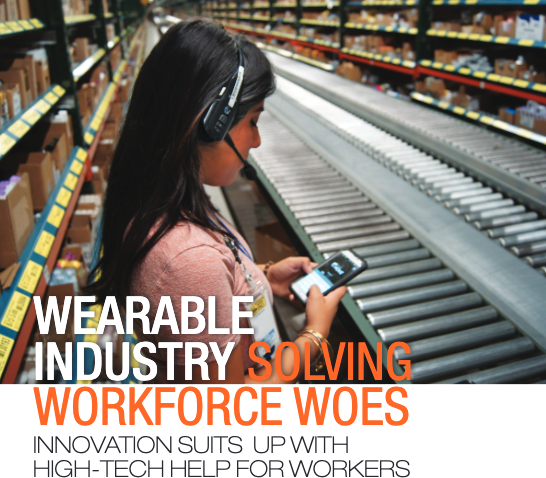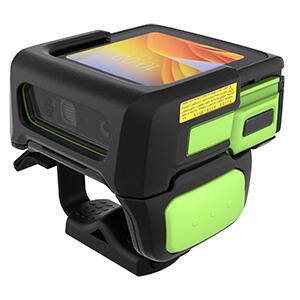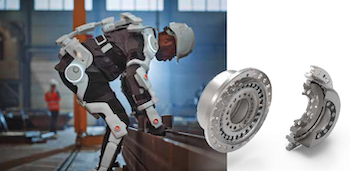Wearable Industry Solving Workforce Woes

by Kim Phelan
Trends associated with the younger spectrum of the workforce have been well documented throughout the national media and every industry in America over the last three years ––the vexing labor shortage phenomenon has become the No. 1 cited headache among CEOs, according to Forbes research. It has also proven to be one of the major catalysts that’s driving product development in today’s industrial wearables market.
“The shortage of workers, especially in the warehouse and distribution sectors, is driving product development that helps reduce training and labor needs,” said Ken Ramoutar, CMO at Lucas Systems. “With the labor shortages predicted to continue for the foreseeable future, there has been a reemphasis on products and features that are geared to reducing labor needs.”
Much of the innovation, he says, is not in the wearables themselves but in the enterprise software that runs on the wearable, he added. Examples include advanced voice recognition that requires near zero training and the use of AI and Machine Learning to reduce on-floor worker travel.
The pervasive difficulty in finding and keeping skilled workers isn’t the only area in which today’s 20-something worker is making an indelible mark on the workplace here and worldwide. Workers, especially Gen Z workers, are demanding better technology to help them do their jobs, according to Ramoutar.
His company recently conducted a survey of 500 warehouse workers that found on-floor workers are willing to trade pay for better technology to do their jobs. Nearly three in four (74%) warehouse workers are at least somewhat likely to take a pay cut to work at another company with more technology tools to help them do their job, including more than half (52%) who are extremely or very likely. This is driven by younger workers, with 81% of workers in the Gen Z group being at least somewhat likely to trade pay for technology.
Yet another trend in wearable product development comes from the rising end-customer demands for speed and accuracy that are putting pressure on suppliers to improve cycle times and order accuracy.
“Many end customers, especially large retailers like Walmart, are steadily increasing their chargeback penalties for late or inaccurate orders. In some cases, the chargeback fees can exceed the anticipated profit on the entire order,” said Ramoutar. “Many wearable manufacturers like Zebra are introducing a newer wave of less intrusive and bulky wearables with multi-mode operations such as scanning, voice, and visual display.”
Lucas Responds with Compatibility Choices
 |
|
Lucas software runs seamlessly on the Zebra WS50, the world’s smallest all-in-one android enterprise-class wearable mobile computer. It is a complete Android device in a ring scanner. |
Lucas Systems, a 25-year veteran in providing technology to both improve the work life of warehouse workers as well as improve the performance of warehouse operations, has continually evolved its technology to meet future market needs. Highlights include:
- Lucas software currently runs on a variety of Android smartphones, wearables, and mobile devices giving customers the largest choice in wearables to run the software on. For example, its software is certified to run seamlessly with products such as the Zebra WS50, a complete Android device in a ring scanner, which is the world’s smallest all-in-one android enterprise-class wearable mobile computer. We are continually testing and certifying new compatible devices to utilize with our software.
- Lucas says it has also continued to set the bar for technology that is intuitive and minimizes the need for long, intensive worker training. For example, with its advanced voice recognition system, suppliers can implement a nearly immediate, no training voice system for new workers. The resulting benefit can be hundreds of training labor hours saved each year for the supplier.
- With the abundance of different languages and accents in the supplier workforce, the need for tech that accommodates the diversity in the workforce is becoming more valuable, especially as labor challenges continue. Lucas offers the ability for a supplier to use its technology in 35 languages. If a worker is speaking English, and a manager best understands Spanish on their device and communication, that preference can be accommodated.
One of Lucas’s newest technologies emphasizes its focus on worker safety and efficiency – the company recently certified its software to run on a bone conduction headset that keeps the user’s ears open to allow them to better hear their environment, including forklifts and other environmental risk factors that may be an impediment around the warehouse.
Ramoutar says Smartwatch use is also on the rise due to its lightweight and hands-free operation. Several manufacturers are releasing a new class of all-in-one Android smartwatches that support voice, speech recognition and have Bluetooth support to connect to wireless headsets and scanners.
“In addition, smart glasses are an emerging form factor for traditional RF applications with limited data input requirements,” he added. “While not commonplace yet due to limited use cases, usability challenges, and battery life, some suppliers are experimenting with this wearable technology.”
The macro issues of labor shortages, the need to attract the Gen Z workforce, and growing end-customer expectations for accuracy and shorter delivery times, will continue, Ramoutar believes. Product changes and improvements that continue to solve those problems will gain adoption.
He cited the following examples:
- Heads-up display. Training could be dramatically reduced by having a heads-up display. Pathfinding could give workers trails to follow to maximize their pick-to-distance ratio. Another benefit would be scan-by-sight, allowing a user or auditor to merely look at a bar code, optionally say a trigger word, and scan something into the system, eliminating scanner hand-use.
- Augmented reality (AR). AR is the next evolution for warehouse wearables. Because it is still relatively new in terms of its maturity cycle and applicable use cases, there are not an abundance of solutions in the marketplace yet. This is an emerging tech area.
- Built-in gamification. Gamification, or competing with your fellow co-workers, is a proven workforce motivational and fun technique. Most of this capability can be done with today’s technology. It’s a matter of setting it up in the enterprise software that feeds the wearables.
The Frontline Worker
Many combined factors influence the development of wearable products at RealWear, according to Chief Product Officer Rama Oruganti. Topping the list are the challenges the industrial frontline worker is facing every day, he said.
“First, technical complexity is rising. Industrial equipment is increasingly complex and requires specialization to operate, maintain, and repair,” said Oruganti. “Second, skilled workers who have the industry, process, and company-specific experiences are harder to find and retain. This secular trend has been accelerated by COVID-19 related disruptions to the labor market.
“Third, information generation and digitization needs are exploding where the frontline worker interacts with physical assets. The information is hard to coalesce,
contextualize, and draw insights from in a succinct, useful, and consumable way.
“And fourth, companies are increasingly aware of both the cognitive load management and situational awareness needed to ensure safety for the frontline workers.”
RealWear Innovates ‘Full Stack’ Solution
 |
|
The RealWear Navigator 520 is the latest ruggedized assisted reality solution designed to engage, empower and elevate the modern frontline professional. |
Oruganti says the changing role of frontline professionals has been exciting as they take on more responsibility and complexity to support their business’s digital
transformation efforts. There are fewer repetitive tasks, a need for more remote collaboration with subject matter experts often who no longer are required to travel due to new technologies such as Zoom, Teams and RealWear.
To address the trends, RealWear has continued to innovate to create a full stack solution – this means world-class hardware, voice recognition in noisy environments, deployment and management cloud, and a 200+ app ecosystem.
Its product platform delivers:
1. The right info and help when and where needed.
2. Optimized skilled worker time; “upleveling” skills and responsibilities becomes automated.
3. A simple, intuitive UX that helps drive quick insights.
4. Complete cognitive and physical focus on task by
having the display out of the primary field of view.
The types of products RealWear is making are still rugged, said Oruganti, but the company is also looking at battery life very carefully, as well as display size to make sure that their devices provide maximum comfort – from viewability, to device weight, balance on the head, etc.
“You can choose a device in your ivory tower,” he said, “but if nobody wants to wear it, it’s not going to make a big difference to your bottom line. We also know that no two frontline professionals are the same, even in the same industry, so we’ve fine-tuned our products for customization and adaptability – even to the point of
having custom-made clips for climbing helmets, as one example. A second example is the modularity of the device – we actually allow the device to be added to or removed depending on the use case.”
Oruganti says RealWear has successfully positioned itself as a pioneer in AR (Assisted Reality), which puts them squarely in the metaverse but in a place that fits with what their customers need – including full situational awareness.
The future-minded company says it is also squarely focused on giving “superpowers” to the industrial frontline workers.
“We will continue to drive significant breakthroughs in hardware, software, cloud, and partner ecosystem that solve the challenges the workers face every day,” said Oruganti.
He says the industry can watch for more implementations of 5G technology, more technologies that work with its Wi-Fi- or Bluetooth-enabled wearables, more interesting displays and dashboards, more partner solutions delivering context using AI, deeper analytics from the cloud, more integration with backend systems, and better leveraging of the data from the device and cloud.
Motion Control Technology
Today’s exoskeletons combine human intelligence, instinct, and judgment with robotic strength and endurance to make tasks safer, easier and more efficient, says Jeff Breakey,
automation sales director at Cone Drive, a part of Timken’s Industrial Motion group.
The company designs and manufacturers an array of harmonic gear solutions used in the joints of exoskeletons, from component gear sets to actuators, which are complete gear motor assemblies.
 “Customers in the wearables market have turned to us to help develop solutions that increase capabilities and improve performance. These wearable solutions can
“Customers in the wearables market have turned to us to help develop solutions that increase capabilities and improve performance. These wearable solutions can
help employers increase productivity, overcome labor shortages and, importantly, improve safety in the
workplace.
We’re known for our ability to quickly develop and deliver custom solutions for our customers’ most challenging problems and applications,” Breakey added. “The wearables market requires lightweight, torque-dense solutions, and Timken is able to meet this need with our specialized engineering expertise.
“We’re in a future-defining period for manufacturing with an emphasis on AI, automation, and robotics solutions. One significant way we’re responding to these trends is by developing and advancing lightweight materials that don’t compromise safety or performance.”
Like electric cars, battery-powered exoskeletons have to get maximum range – or productivity in this case – out of a single charge, which makes light-weighting extremely important. The fact that exoskeletons are worn by people makes weight reduction even more crucial, Breakey wrote on LinkedIn.
“To reduce mass, Cone Drive engineers start with standard harmonic gear drives and optimize the design to be lighter weight while retaining the same performance ratings,” he said. “The high-gear ratio inherent in the design leads to greater torque capacity — which is critical to ensuring the exoskeleton joints are as flexible as the humans wearing them.”
Cone Drive’s Harmonic Solutions technology enables the exoskeleton’s precise motion and positioning. This mechanical gear system allows exoskeletons to move more fluidly with the worker’s body – reducing musculoskeletal strain and improving productivity.












